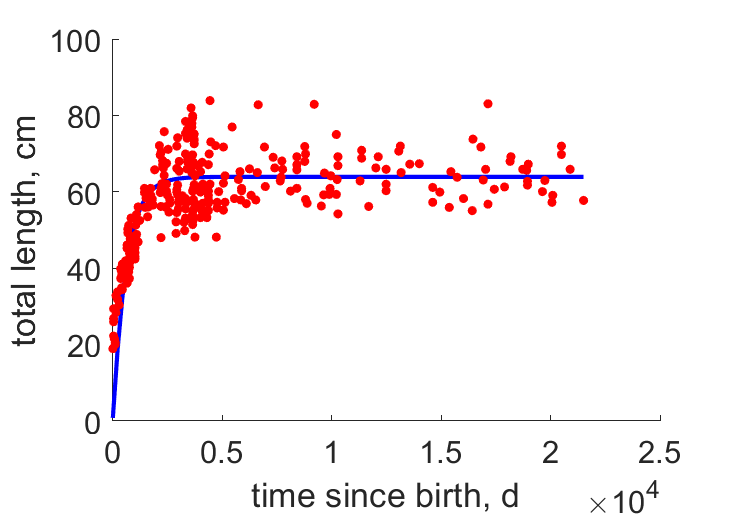Predictions & Data for this entry
| Model: abj | climate: MC | migrate: | phylum: |
| COMPLETE = 2.5 | ecozone: MPN | food: biCi | class: |
| MRE = 0.062 | habitat: 0iMcd | gender: D | order: |
| SMSE = 0.008 | embryo: Mp | reprod: O | family: |
Zero-variate data
| Data | Observed | Predicted | (RE) | Unit | Description | Reference |
|---|---|---|---|---|---|---|
| ab | 14.5 | 16.98 | (0.171) | d | age at birth | ClarJens1999, AldeJens1988 |
| am | 3.431e+04 | 3.782e+04 | (0.1022) | d | life span | fishbase |
| Lp | 60.5 | 62.1 | (0.02647) | cm | total length at puberty for female | fishbase |
| Li | 120 | 122.4 | (0.02024) | cm | ultimate total length for female | fishbase |
| Wwb | 0.0046 | 0.004257 | (0.07465) | g | wet weight at birth | ClarJens1999 |
| Wwp | 2300 | 2288 | (0.005123) | g | wet weight at puberty | fishbase |
| Wwi | 1.77e+04 | 1.753e+04 | (0.009488) | g | ultimate wet weight for female | fishbase |
| Ri | 2740 | 2650 | (0.03268) | #/d | max reprod rate | fishbase |
Uni- and bivariate data
| Data | Figure | Independent variable | Dependent variable | (RE) | Reference |
|---|---|---|---|---|---|
| tL |  | time since birth | total length | (0.1073) | HeadKell2014 |
Pseudo-data at Tref = 20°C
| Data | Generalised animal | Anoplopoma fimbria | Unit | Description |
|---|---|---|---|---|
| v | 0.02 | 0.02482 | cm/d | energy conductance |
| p_M | 18 | 9882 | J/d.cm^3 | vol-spec som maint |
| k_J | 0.002 | 0.002 | 1/d | maturity maint rate coefficient |
| k | 0.3 | 0.001045 | - | maintenance ratio |
| kap | 0.8 | 0.7337 | - | allocation fraction to soma |
| kap_G | 0.8 | 0.81 | - | growth efficiency |
| kap_R | 0.95 | 0.95 | - | reproduction efficiency |
Discussion
- Males are assumed not to differ from females
- abj has been applied since related species show acceleration; foetal development was ignored because of absence of its combination with abj. The effect is probably very small.
- mod_1: p_M is reduced
Facts
- legnth-weight: Ww in g =0.01122*(TL in cm)^2.98 (Ref: fishbase)
Acknowledgment
- The creation of this entry was supported by the Norwegian Science Council (NFR 255295)
Bibliography